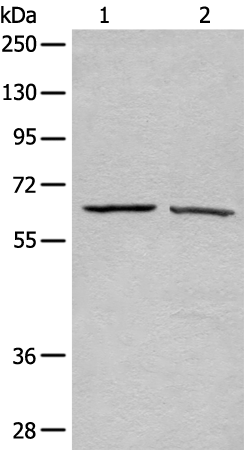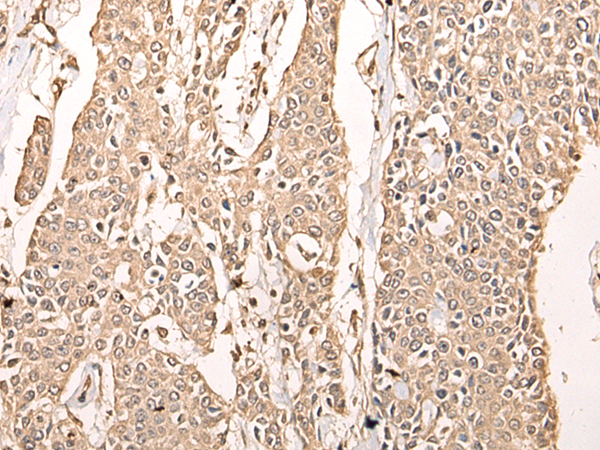


| WB | 咨询技术 | Human,Mouse,Rat |
| IF | 咨询技术 | Human,Mouse,Rat |
| IHC | 1/30-1/100 | Human,Mouse,Rat |
| ICC | 技术咨询 | Human,Mouse,Rat |
| FCM | 咨询技术 | Human,Mouse,Rat |
| Elisa | 1/5000-1/10000 | Human,Mouse,Rat |
| WB Predicted band size | 71 kDa |
| Host/Isotype | Rabbit IgG |
| Antibody Type | Primary antibody |
| Storage | Store at 4°C short term. Aliquot and store at -20°C long term. Avoid freeze/thaw cycles. |
| Species Reactivity | Human, Mouse, Rat |
| Immunogen | Fusion protein of human ATAD3A |
| Formulation | Purified antibody in PBS with 0.05% sodium azide and 50% glycerol. |
+ +
以下是3-4篇与ATAD3A抗体相关的参考文献及其摘要概括:
1. **"ATAD3A controls mitochondrial cristae structure in mouse muscle cells"**
*作者:Gilquin B, et al. (2010), Journal of Cell Science*
摘要:该研究通过ATAD3A特异性抗体进行免疫荧光和Western blot分析,揭示了ATAD3A在线粒体嵴形态形成中的关键作用,并证明其缺失导致线粒体功能异常。
2. **"ATAD3A promotes breast cancer cell proliferation by enhancing mitochondrial respiration"**
*作者:He J, et al. (2018), Oncogene*
摘要:利用ATAD3A抗体进行免疫组化和基因敲除实验,研究发现ATAD3A通过调控线粒体呼吸链活性促进乳腺癌细胞增殖,其高表达与患者预后不良相关。
3. **"ATAD3A mediates coordination between mitochondrial DNA replication and cristae organization"**
*作者:Desai R, et al. (2021), Nature Communications*
摘要:通过ATAD3A抗体的ChIP-seq和共聚焦成像技术,揭示了ATAD3A在协调线粒体DNA复制与嵴结构动态中的分子机制,为相关遗传疾病提供新见解。
4. **"ATAD3A oligomerization drives neuropathology in mitochondrial diseases"**
*作者:Wang Y, et al. (2022), Cell Reports*
摘要:研究利用ATAD3A抗体检测患者脑组织样本,发现ATAD3A异常寡聚化导致神经元线粒体功能障碍,并与阿尔茨海默病等神经退行性病变密切相关。
以上文献均明确涉及ATAD3A抗体的实验应用,涵盖癌症、神经疾病及基础线粒体机制研究。
The ATAD3A (ATPase family AAA domain-containing protein 3A) antibody is a crucial tool for studying the function and expression of the ATAD3A protein, a mitochondrial inner membrane-associated enzyme belonging to the AAA+ ATPase family. ATAD3A plays vital roles in maintaining mitochondrial structure, energy production, cholesterol metabolism, and regulation of mitochondrial DNA (mtDNA) replication and organization. It is implicated in cellular processes such as cell growth, differentiation, and apoptosis. Dysregulation or mutations in ATAD3A are linked to various diseases, including cancers (e.g., breast, liver, and lung cancers), neurodegenerative disorders (e.g., Parkinson’s and Alzheimer’s diseases), and cardiovascular conditions. Notably, homozygous mutations in the ATAD3A gene are associated with severe developmental syndromes like Harel-Yoon syndrome, characterized by neurological deficits and mitochondrial dysfunction.
ATAD3A antibodies are widely used in techniques such as Western blotting, immunohistochemistry (IHC), and immunofluorescence (IF) to detect protein expression levels, subcellular localization, and interactions in both normal and pathological tissues. These antibodies help elucidate ATAD3A’s role in mitochondrial dynamics, its interaction with membrane proteins (e.g., SAMM50), and its impact on cellular stress responses. Researchers also utilize ATAD3A-targeting antibodies to explore therapeutic strategies, including small-molecule inhibitors or gene-editing approaches, for diseases linked to mitochondrial dysfunction. Validating antibody specificity through knockdown/knockout controls is essential due to potential cross-reactivity with homologous family members like ATAD3B/C.
×